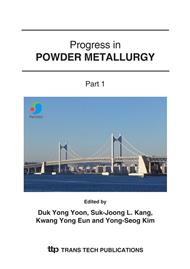p.5
p.9
p.13
p.17
p.21
p.25
p.29
p.33
p.37
Characteristics of Porous YAG Powders Fabricated by PVA Polymer Solution Technique
Abstract:
Pure and stable YAG (Y3Al5O12) powders were synthesized by a PVA (polyvinyl alcohol) polymer solution technique. PVA was used as an organic carrier for the precursor ceramic gel. The PVA affected crystallization behavior, powder morphology, specific surface area and crystalline size of the synthesized powders. The precursor gels were crystallized to YAG at relatively a low temperature of 900 °C. The synthesized powders, which have nano-sized primary particles, were soft and porous, and the porous powders were ground to sub-micron size by a simple ball milling process. The ball-milled powders were densified to 94% relative density at 1500 °C for 1h. In this study, the characteristics of the synthesized YAG powders were examined by using X-ray diffractometer, simultaneous differential scanning calorimetry and electrophoretic light scattering spectrophotometer. And the morphologies of the powders and the densified samples were observed by scanning electron microscopy.
Info:
Periodical:
Pages:
21-24
Citation:
Online since:
January 2007
Authors:
Keywords:
Price:
Сopyright:
© 2007 Trans Tech Publications Ltd. All Rights Reserved
Share:
Citation:


